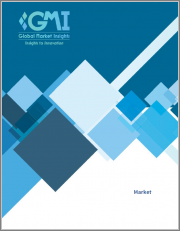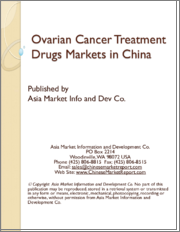
|
시장보고서
상품코드
1411275
난소암 치료제 시장 : 암종별, 치료 유형별, 투여 경로별, 최종 사용자별(2024-2032년 예측)Ovarian Cancer Treatment Drugs Market - By Cancer Type (Epithelial, Stromal, Germ Cell), By Treatment Type (Targeted Therapy, Immunotherapy, Chemotherapy), By Route of Administration (Oral, Intravenous), By End-user & Forecast, 2024 - 2032 |
||||||
난소암 치료제 시장 규모는 개인 맞춤형 의료 트렌드의 영향력 증가로 2024년부터 2032년까지 연평균 복합 성장률(CAGR) 6.3%를 나타낼 것으로 전망됩니다.
유전자 프로파일링과 바이오마커 탐색의 발전은 맞춤형 의약품 개발을 촉진하여 환자의 예후를 개선할 수 있습니다. 또한, 의료 기술과 진단 방법의 개선으로 혁신적이고 효과적인 난소암 치료제가 개발되고 있습니다. 예를 들어, 2022년 11월 이뮤노젠은 진행성 난소암 치료제 엘라헤어(Elahere)에 대한 첫 FDA 승인을 획득했습니다.
또한, 제약회사, 연구기관, 의료 기관 간의 협력이 증가함에 따라 난소암 치료제 개발이 가속화되고 있으며, 이는 산업 성장에 박차를 가하고 있습니다. 예를 들어, 2023년 6월 USask(서스캐처원대학)의 부인과 암 전문가와 병리학 전문가가 공동으로 난소암 환자의 종양을 조사하여 새로운 유형의 약물에 대한 반응성을 나타내는 다양한 돌연변이를 조사했습니다.
난소암 치료제 시장은 암종, 치료 유형, 투여 경로, 최종 사용자 및 지역으로 분류됩니다.
치료 유형별로는 화학요법 분야 시장 점유율이 2024년부터 2032년까지 연평균 복합 성장률(CAGR)6.7%를 나타낼 것으로 예상됩니다. 화학요법은 난소암의 초기 치료와 재발 치료에서 매우 중요한 역할을 하기 때문에 난소암의 치료법으로 주목받고 있습니다. 화학요법 요법의 강화, 새로운 약물의 병용, 치료 결과 개선 및 생존율 연장을 위한 표적치료제 등의 연구개발 노력이 지속되고 있는 것도 이 부문의 성장을 뒷받침하고 있습니다.
최종 사용자별로 보면, 난소암 치료제 산업은 2023년 소매 약국 부문에서 큰 매출을 기록했으며, 2024년부터 2032년까지 6.2%의 연평균 복합 성장률(CAGR)을 나타낼 것으로 추정됩니다. 이러한 성장은 난소암 치료제에 대한 접근성뿐만 아니라 환자 편의성 향상에 있어 소매 약국이 부상하고 있기 때문입니다. 또한, 헬스케어 부문의 인식과 교육 이니셔티브 증가는 이 분야의 성장을 더욱 촉진할 것으로 보입니다.
지역별로 보면, 아시아태평양의 난소암 치료제 산업은 2024-2032년 동안 연평균 6.6%의 강력한 성장세를 보일 것으로 예상됩니다. 이는 난소암 발병률 증가, 인지도 향상, 의료 인프라 개선에 기인합니다. 예를 들어, 2023년 발표된 NCBI 통계에 따르면, 아태지역 여성의 난소암 발병률은 10만 명당 9.2명입니다. 이 지역에서는 조기 발견과 고급 치료 옵션에 대한 관심이 높아지면서 난소암 치료제에 대한 수요도 증가하고 있습니다. 또한, 정책, 임상 연구 및 새로운 치료제의 가용성은 지역 시장 확대를 더욱 가속화할 것으로 예상됩니다.
목차
제1장 조사 방법과 조사 범위
제2장 주요 요약
제3장 난소암 치료제 시장 인사이트
- 업계 상황
- 업계에 대한 영향요인
- 성장 촉진요인
- 업계의 잠재적 리스크&과제
- 성장 가능성 분석
- 암 유형별
- 치료 유형별
- 투여 경로별
- 최종사용자별
- 규제 상황
- 파이프라인 분석
- Porter's Five Forces 분석
- PESTEL 분석
제4장 경쟁 구도
- 서론
- 기업 매트릭스 분석
- 주요 시장 기업 - 경쟁 분석
- 경쟁 포지셔닝 매트릭스
- 전략 대시보드
제5장 난소암 치료제 시장 추정·주요 동향 예측 : 암 유형별, 2018년-2032년
- 주요 동향 : 암 유형별
- 상피성 난소암
- 기질 종양
- 생식세포 종양
제6장 난소암 치료제 시장 추정·예측 : 치료 유형별, 2018년-2032년
- 주요 동향 : 치료 유형별
- 표적 치료제
- PARP 억제제
- 혈관신생 억제제
- 기타 표적 치료제
- 면역치료제
- 화학요법
- 호르몬 요법
- 방사선 요법
제7장 난소암 치료제 시장 추산·예측 : 투여 경로별, 2018년-2032년
- 주요 동향 : 투여 경로별
- 경구
- 정맥내
- 복강내
제8장 난소암 치료제 시장 추정·예측 : 최종사용자별, 2018-2032년
- 주요 동향 : 최종사용자별
- 병원 약국
- 소매 약국
- 기타 최종사용자
제9장 난소암 치료제 시장 추정·예측 : 지역별, 2018년-2032년
- 주요 동향 : 지역별
- 북미
- 미국
- 캐나다
- 유럽
- 독일
- 영국
- 프랑스
- 스페인
- 이탈리아
- 기타 유럽
- 아시아태평양
- 중국
- 일본
- 인도
- 호주
- 기타 아시아태평양
- 라틴아메리카
- 브라질
- 멕시코
- 기타 라틴아메리카
- 중동 및 아프리카
- 남아프리카공화국
- 사우디아라비아
- 기타 중동 및 아프리카
제10장 기업 개요
- F. Hoffmann-La Roche AG
- GlaxoSmithKline Plc.
- Immunogen Inc.
- Astrazeneca
- Merck KGaA
- Oasmia Pharmaceutical AB
- Clovis Oncology, Inc.
- Novartis AG
- Bristol-Myers Squibb Company
- Pfizer Inc.
- Eli Lilly and Company
- Aravive Biologics
- Allarity Therapeutics
Ovarian Cancer Treatment Drugs Market size is poised to depict 6.3% CAGR between 2024 and 2032 owing to the increasing influence of personalized medicine trends. Advances in genetic profiling and biomarker discovery are facilitating the creation of customized medicines, leading to better patient outcomes. Additionally, improvements in medical technology and diagnostics have led to the development of innovative and more effective ovarian cancer treatment medications. For instance, in November 2022, ImmunoGen earned its first FDA clearance for its medicine, Elahere, to treat advanced ovarian cancer.
Furthermore, the rising collaborations between pharmaceutical corporations, research institutes, and healthcare organizations are accelerating the development of ovarian cancer treatment drugs, adding to the industry growth. For instance, in June 2023, USask (University of Saskatchewan) gynecologic cancer specialists and pathology specialists collaborated to examine the tumors of ovarian cancer patients for a variety of mutations that indicate responsiveness to a new class of medications.
The ovarian cancer treatment drugs market is segmented into cancer type, treatment type, route of administration, end-user, and region.
Based on treatment type, the market share from the chemotherapy segment is likely to witness 6.7% CAGR between 2024 and 2032. Chemotherapy has emerged as a preferred ovarian cancer treatment as it plays a pivotal role in both first-line and recurrent ovarian cancer cases. The ongoing R&D efforts to enhance chemotherapy regimens, novel drug combinations, and targeted therapies for offering improved outcomes and extended survival rates will also support the segment expansion.
In terms of end-user, the ovarian cancer treatment drugs industry recorded significant sales from the retail pharmacies segment in 2023 and is estimated to depict a 6.2% CAGR from 2024 to 2032. The growth can be attributed to the rising prominence of retail pharmacies in offering enhanced convenience to patients as well as accessibility to essential ovarian cancer treatment drugs. Additionally, the growing awareness and education initiatives in the healthcare sector will further drive the segment growth.
Regionally, the Asia Pacific ovarian cancer treatment drugs industry is set to exhibit robust growth at 6.6% CAGR during 2024-2032, attributed to the escalating incidences of ovarian cancer, rising awareness, and the presence of improved healthcare infrastructure. For instance, according to NCBI statistics released in 2023, the rate of ovarian cancer among APAC women is 9.2 per 100,000. The growing emphasis on early detection and advanced treatment options in the region is also propelling the demand for ovarian cancer treatment drugs. Additionally, government initiatives, clinical research, and the availability of novel therapeutics will further accelerate the regional market expansion.
Table of Contents
Chapter 1 Methodology & Scope
- 1.1 Market definition
- 1.2 Base estimates & calculations
- 1.3 Forecast calculation
- 1.4 Data validation
- 1.5 Data sources
- 1.5.1 Primary
- 1.5.2 Secondary
- 1.5.2.1 Paid sources
- 1.5.2.2 Public sources
Chapter 2 Executive Summary
- 2.1 Ovarian cancer treatment drugs industry 360 degree synopsis, 2018 - 2032 (USD Million)
- 2.1.1 Business trends
- 2.1.2 Regional trends
- 2.1.3 Cancer type trends
- 2.1.4 Treatment type trends
- 2.1.5 Route of administration trends
- 2.1.6 End-user trends
Chapter 3 Ovarian Cancer Treatment Drugs Market Insights
- 3.1 Industry landscape, 2018 - 2032 (USD Million)
- 3.2 Industry impact forces
- 3.2.1 Growth drivers
- 3.2.1.1 Rising incidence of ovarian cancer
- 3.2.1.2 Increasing investments in R&D activities
- 3.2.1.3 Increasing demand for novel treatment for ovarian cancer
- 3.2.1.4 Growing awareness and early detection
- 3.2.2 Industry pitfalls & challenges
- 3.2.2.1 Adverse effects associated with the treatment
- 3.2.1 Growth drivers
- 3.3 Growth potentialanalysis
- 3.3.1 By cancer type
- 3.3.2 By treatment type
- 3.3.3 By route of administration
- 3.3.4 By end-user
- 3.4 Regulatory landscape
- 3.5 Pipelineanalysis
- 3.6 Porter'sanalysis
- 3.7 PESTELanalysis
Chapter 4 Competitive Landscape, 2023
- 4.1 Introduction
- 4.2 Company matrixanalysis, 2023
- 4.3 Competitiveanalysis of major market players, 2023
- 4.4 Competitive positioning matrix, 2023
- 4.5 Strategic dashboard, 2023
Chapter 5 Ovarian Cancer Treatment Drugs Market Estimates and Forecast, By Cancer Type, 2018-2032 (USD Million)
- 5.1 Key trends, by cancer type
- 5.2 Epithelial ovarian cancer
- 5.3 Stromal tumors
- 5.4 Germ cell tumors
Chapter 6 Ovarian Cancer Treatment Drugs Market Estimates and Forecast, By Treatment Type, 2018-2032 (USD Million)
- 6.1 Key trends, by treatment type
- 6.2 Targeted therapy drugs
- 6.2.1 PARP inhibitors
- 6.2.2 Angiogenesis inhibitors
- 6.2.3 Other targeted therapy drugs
- 6.3 Immunotherapy drugs
- 6.4 Chemotherapy drugs
- 6.5 Hormone therapy drugs
- 6.6 Radiation therapy
Chapter 7 Ovarian Cancer Treatment Drugs Market Estimates and Forecast, By Route of Administration, 2018-2032 (USD Million)
- 7.1 Key trends, by route of administration
- 7.2 Oral
- 7.3 Intravenous
- 7.4 Intraperitoneal
Chapter 8 Ovarian Cancer Treatment Drugs Market Estimates and Forecast, By End-user, 2018-2032 (USD Million)
- 8.1 Key trends, by end-user
- 8.2 Hospital pharmacies
- 8.3 Retail pharmacies
- 8.4 Other end-users
Chapter 9 Ovarian Cancer Treatment Drugs Market Estimates and Forecast, By Region, 2018 - 2032 (USD Million)
- 9.1 Key trends, by region
- 9.2 North America
- 9.2.1 U.S.
- 9.2.2 Canada
- 9.3 Europe
- 9.3.1 Germany
- 9.3.2 UK
- 9.3.3 France
- 9.3.4 Spain
- 9.3.5 Italy
- 9.3.6 Rest of Europe
- 9.4 Asia Pacific
- 9.4.1 China
- 9.4.2 Japan
- 9.4.3 India
- 9.4.4 Australia
- 9.4.5 Rest of Asia Pacific
- 9.5 Latin America
- 9.5.1 Brazil
- 9.5.2 Mexico
- 9.5.3 Rest of Latin America
- 9.6 Middle East & Africa
- 9.6.1 South Africa
- 9.6.2 Saudi Arabia
- 9.6.3 Rest of Middle East & Africa
Chapter 10 Company Profiles
- 10.1 F. Hoffmann-La Roche AG
- 10.2 GlaxoSmithKline Plc.
- 10.3 Immunogen Inc.
- 10.4 Astrazeneca
- 10.5 Merck KGaA
- 10.6 Oasmia Pharmaceutical AB
- 10.7 Clovis Oncology, Inc.
- 10.8 Novartis AG
- 10.9 Bristol-Myers Squibb Company
- 10.10 Pfizer Inc.
- 10.11 Eli Lilly and Company
- 10.12 Aravive Biologics
- 10.13 Allarity Therapeutics










